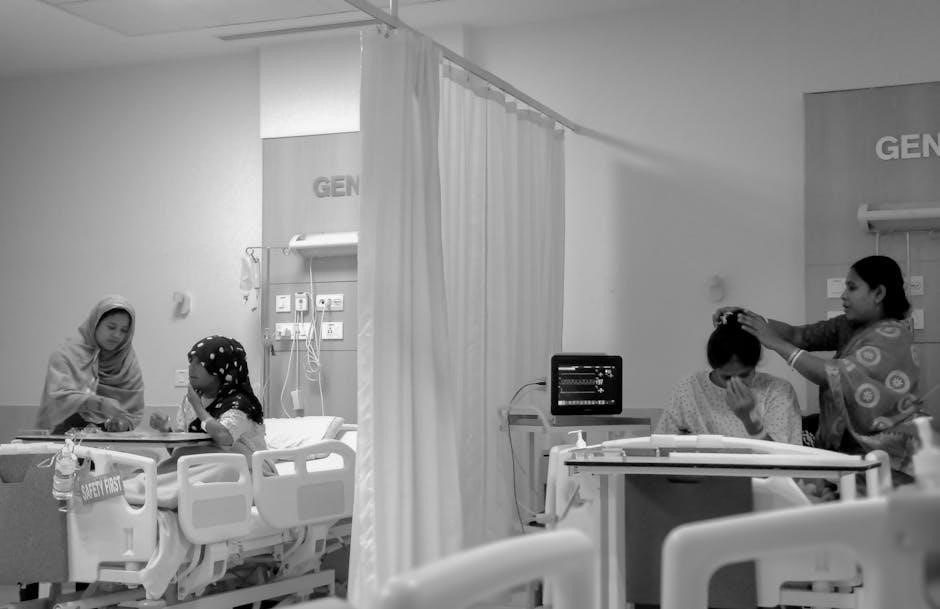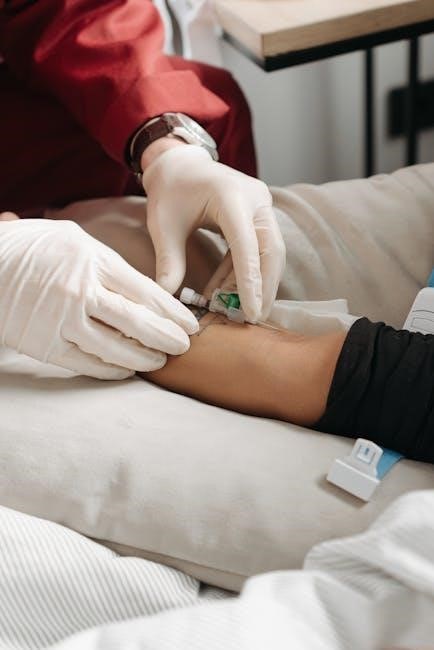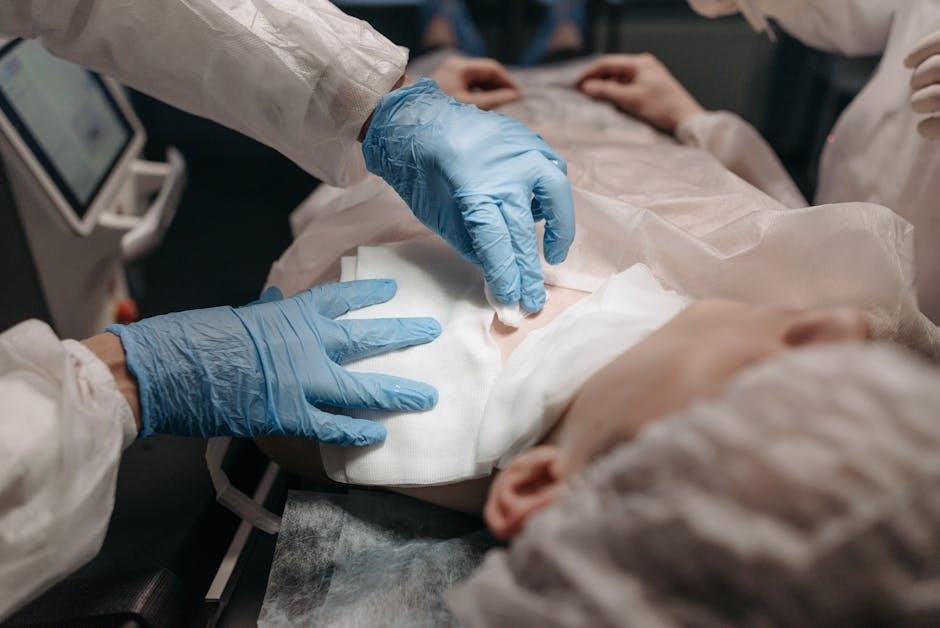The nursing process is a systematic, evidence-based approach to deliver high-quality, individualized patient care. It involves assessment, diagnosis, planning, implementation, and evaluation to ensure effective care outcomes.
1.1 Definition and Purpose

The nursing process is a systematic, evidence-based method for delivering patient care. It emphasizes individualized, holistic, and efficient care, addressing both physical and emotional needs. The purpose is to provide a structured approach to identifying health issues, planning interventions, and evaluating outcomes. This process ensures continuity of care, promotes critical thinking, and enhances patient safety. By focusing on assessment, diagnosis, planning, implementation, and evaluation, it offers a clear framework for nurses to deliver consistent, high-quality, and compassionate care tailored to each patient’s unique needs.
1.2 Historical Development
The nursing process originated in the mid-20th century, with Lydia Hall introducing the term in 1955. Early models focused on observation, care, and validation. Dorothy Johnson expanded it in 1959, emphasizing assessment, decision-making, and action. Ida Jean Orlando further refined it in the 1960s, highlighting client behavior and nurse responses. By the 1970s, the modern five-step framework—assessment, diagnosis, planning, implementation, and evaluation—emerged, becoming a global standard for systematic, patient-centered care. This evolution reflects nursing’s commitment to evidence-based, holistic practice.
1.3 Importance in Patient Care
The nursing process is vital for delivering consistent, high-quality patient care. It ensures individualized, holistic approaches by addressing physical, emotional, and social needs. This systematic method reduces errors, enhances communication among healthcare teams, and promotes better patient outcomes. By fostering critical thinking and adaptability, the nursing process enables nurses to respond effectively to diverse patient conditions, ultimately improving safety and satisfaction. Its structured approach also supports accountability and continuity of care, making it essential for modern healthcare systems.
Assessment in the Nursing Process
Assessment involves systematically collecting objective and subjective data about a patient’s health status. It uses tools like questionnaires and physical exams to identify health needs and changes.
2.1 Data Collection Methods
Data collection in the nursing process involves gathering both objective and subjective information. Objective data includes measurable facts like vital signs, lab results, and physical assessment findings. Subjective data encompasses patient-reported symptoms, feelings, and medical histories. Methods include interviews, questionnaires, physical examinations, and observations. Tools like assessment checklists and electronic health records aid in organizing information. Accurate and thorough data collection is essential for identifying patient needs and developing effective care plans.

2.2 Types of Data: Objective vs. Subjective
Objective data are measurable and observable, such as vital signs, lab results, and physical examination findings. These can be quantified and verified by others. Subjective data are patient-reported, including symptoms, feelings, and perceptions, which are personal and cannot be measured. Together, these data types provide a comprehensive understanding of the patient’s health status, aiding in accurate diagnosis and effective care planning.
2.3 Tools and Techniques for Effective Assessment
Effective assessment employs various tools and techniques to gather accurate data. These include primary surveys, admission assessments, and head-to-toe evaluations. Tools like the Glasgow Coma Scale and pain assessment scales aid in quantifying findings. Techniques such as active listening and therapeutic communication enhance data collection. Documentation methods, including nursing notes and care plans, organize findings. Regular reassessments ensure ongoing evaluation of patient status, facilitating timely interventions and improving care outcomes.

Diagnosis in the Nursing Process
Diagnosis involves interpreting assessment data to identify health issues. Nurses use evidence-based sources to formulate accurate diagnoses, ensuring effective care planning and intervention.
3.1 Identifying Nursing Diagnoses
Identifying nursing diagnoses involves analyzing assessment data to determine actual or potential health problems. Nurses use standardized taxonomies like NANDA-I to define diagnoses accurately. This step ensures care is tailored to address specific patient needs, promoting effective outcomes. Evidence-based sources guide diagnosis formulation, reducing errors. Collaboration with healthcare teams enhances accuracy, ensuring comprehensive care plans.
3.2 Using Evidence-Based Sources for Accurate Diagnosis
Nurses rely on evidence-based sources, such as NANDA-I taxonomies, to formulate accurate diagnoses. These sources provide standardized definitions and criteria for identifying health problems. By referencing evidence-based guidelines, nurses ensure diagnoses are valid and relevant. This approach reduces errors and variability in care. It also enhances the development of targeted interventions, improving patient outcomes. Using credible resources fosters consistency and confidence in diagnostic decision-making, aligning care with best practices and current research.
3.3 Prioritizing Diagnoses for Effective Care Planning
Prioritizing diagnoses ensures effective care planning by addressing the most critical patient needs first. Nurses use criteria like urgency, severity, and potential impact to rank diagnoses. This step ensures resources are allocated efficiently and high-priority issues are resolved promptly. Tools like the ABCD framework (Acuity, chronicity, complexity, stability) guide prioritization. By focusing on the most impactful diagnoses, nurses optimize patient outcomes and streamline care delivery. This systematic approach ensures comprehensive and patient-centered care plans.
Planning in the Nursing Process
Planning involves creating a tailored care plan with SMART goals, interventions, and outcomes. It ensures coordinated, effective care through collaboration with the healthcare team and patient input.

4.1 Developing a Comprehensive Care Plan
A comprehensive care plan outlines individualized patient goals, interventions, and outcomes. It involves collaboration with the patient, family, and healthcare team to ensure holistic care. The plan is based on nursing diagnoses and evidence-based practices, ensuring it addresses physical, emotional, and social needs. SMART goals are established to guide interventions, making outcomes measurable and achievable. The care plan is dynamic, allowing for adjustments based on patient progress and changing needs. Effective documentation ensures continuity of care and clear communication among team members.
4.2 Setting SMART Goals and Outcomes
SMART goals are Specific, Measurable, Achievable, Relevant, and Time-bound objectives. They guide patient care by ensuring clarity and focus. Specific goals clearly define what the patient aims to achieve. Measurable outcomes allow tracking progress. Achievable goals are realistic based on the patient’s capabilities. Relevant goals align with the patient’s needs and priorities. Time-bound goals set clear deadlines. Incorporating SMART criteria enhances goal attainment, patient motivation, and evaluation of care effectiveness, ensuring personalized and evidence-based care.
4.3 Collaborative Planning with the Healthcare Team
Collaborative planning involves coordinating with healthcare professionals to develop comprehensive care strategies. Nurses work with doctors, therapists, and specialists to align goals and interventions; Effective communication ensures a unified approach, enhancing patient outcomes. This teamwork fosters a holistic understanding of the patient’s needs, promoting consistent and high-quality care. By integrating diverse perspectives, collaborative planning optimizes resource use and reduces fragmentation, ultimately benefiting the patient and their care journey.

Implementation in the Nursing Process
Implementation involves executing the care plan through targeted nursing interventions. Nurses monitor patient responses, document progress, and adjust actions as needed to ensure effective care delivery and desired outcomes.
5.1 Carrying Out Nursing Interventions
Carrying out nursing interventions involves executing the planned actions to address patient needs. Nurses administer medications, perform procedures, educate patients, and provide emotional support. Interventions are tailored to individual patient requirements, ensuring safety and effectiveness. Continuous monitoring of patient responses is essential to adapt care as needed. This step requires strong clinical skills, critical thinking, and collaboration with the healthcare team to achieve desired outcomes and promote patient well-being.
5.2 Monitoring and Adjusting Care Plans
Monitoring involves continuously observing patient progress and responses to interventions. Nurses compare outcomes with established goals to identify effectiveness. Adjustments are made based on new data or changes in the patient’s condition. This dynamic process ensures care remains relevant and patient-centered, addressing evolving needs promptly. Regular communication with the healthcare team and patient feedback are crucial for refining the care plan and optimizing results. Adjustments may include modifying interventions, updating goals, or escalating care when necessary to enhance patient outcomes and satisfaction effectively.
5.3 Documenting Actions and Progress
Documenting actions and progress is essential for accountability, continuity of care, and legal compliance. Nurses record interventions, patient responses, and outcomes in the medical record. This includes details of care provided, medications administered, and any changes in the patient’s condition. Accurate documentation ensures clear communication among healthcare providers and supports future care decisions. Using standardized frameworks or electronic health systems can enhance clarity and accessibility of records, promoting transparency and improving overall patient care quality and safety effectively.
Evaluation in the Nursing Process
Evaluation involves systematically assessing patient outcomes to determine goal achievement and the effectiveness of care. It ensures continuous quality improvement by identifying areas for adjustment and refining interventions.
6.1 Assessing Goal Achievement
Assessing goal achievement involves evaluating whether the established outcomes have been met. This step ensures accountability and provides insights into the effectiveness of care. Nurses compare the patient’s current status to the predefined goals, using objective and subjective data. Tools like care plans and progress reports aid in this process. Achieved goals indicate successful care, while unmet goals may require revising interventions. This step is crucial for maintaining high-quality care and ensuring patient-centered outcomes are prioritized.
6.2 Identifying Outcomes and Modifications
Evaluation involves identifying specific outcomes and determining if modifications are needed. Nurses analyze data to assess progress toward goals. If outcomes are not met, the care plan is revised to address barriers or new needs. Modifications may include adjusting interventions, setting new priorities, or involving other healthcare professionals. This step ensures flexibility and responsiveness, promoting optimal patient care and continuous improvement in outcomes. Regular reassessment and adaptability are key to effective care delivery.
6.3 Continuous Quality Improvement
Continuous quality improvement (CQI) in the nursing process involves systematically evaluating and enhancing care delivery. By analyzing outcomes and identifying gaps, nurses can refine practices to improve patient care. This step fosters a culture of accountability and lifelong learning, ensuring evidence-based standards are met. Regular feedback and data-driven decisions help reduce health disparities and optimize resource use, ultimately enhancing patient outcomes and satisfaction. CQI integrates seamlessly with the nursing process, serving as a framework for ongoing professional development and organizational excellence in healthcare settings.

